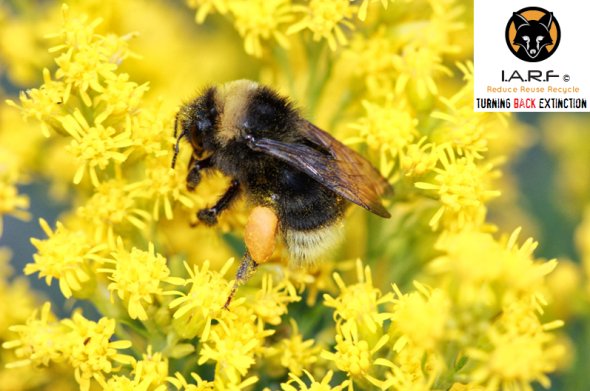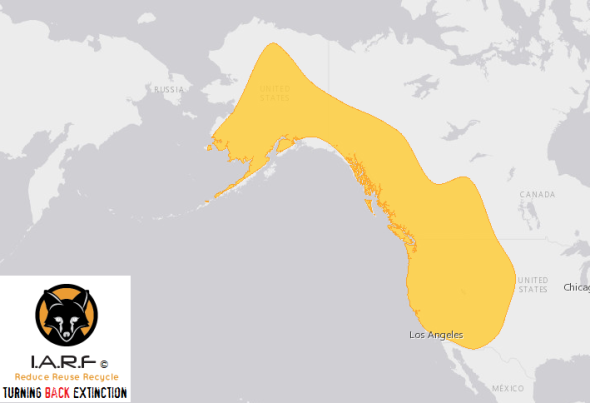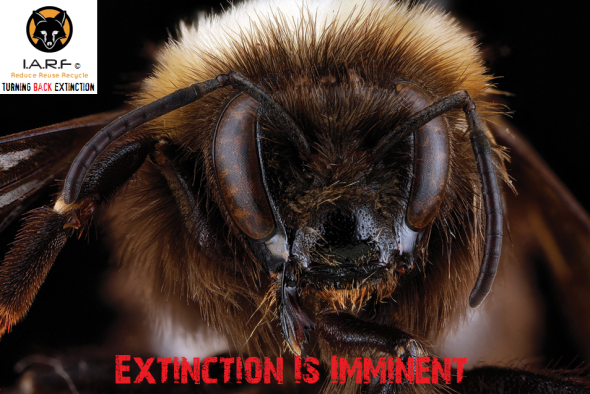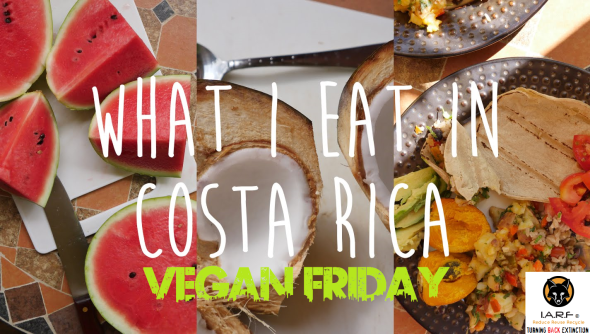Endangered Species Monday: Bombus occidentalis |Extinction is Imminent.
Endangered Species Monday: Bombus occidentalis
“1/3 bites of food we eat comes from a plant that was pollinated by a bee”
What are we humans doing to Planet Earth?, We are destroying so many pollinating animals, that soon they’ll be none left. When or if that day occurs, when there are no more pollinators, we ourselves will be fighting to stay alive, can you imagine that? Human extinction is slowly in the making… …No matter how many vegans or vegetarians there are, we all require plants. No plants = No life!
That’s a Scientific Fact of Life!
Dr Jose Depre
This Monday’s Endangered Species Post (E.S.P) I document on the Western Bumble Bee. Scientifically identified as Bombus occidentalis this particular species of bee is listed as (vulnerable), and is now nearing complete extinction within the wild, despite conservation efforts aimed at reducing dangers, things certainly are not looking good for the bee, or crops the species pollinates either. Image credits: Rich Hatfield
The species was identified back in 1858 by Dr Edward Lee Greene, Ph.D, (August 10, 1843 – November 10, 1915) was an American botanist known for his numerous publications including the two-part Landmarks of Botanical History and the naming or redescribing of over 4,400 species of plants in the American West.
Endemic to: Canada (Alberta, British Columbia, Northwest Territories, Saskatchewan, Yukon); United States (Alaska, Arizona, California, Colorado, Idaho, Montana, Nebraska, Nevada, New Mexico, Oregon, South Dakota, Utah, Washington, and Wyoming). To date we still don’t know what the “exact current rate of decline is”, or even if the Western Bumble Bee is going to be with us within the next decade. Its ‘likely that based on current surveys the species will be extinct within the next 10 years (max)”.
Since 2008-2014 there has been quite a significant rate of decline st 11%-12%, sparking concerns that the Western Bumble Bee ‘may eventually be listed as critically endangered’ within the United States and Canada. Scientists confirmed that in one area which is [unknown], possibly the United States via field surveys the species was not found during the years of 2003-2007 (which is of course quite concerning), especially when the species is a major pollinator, and has been seen only in very low numbers at (one to seven per year) each year from 2008 to 2014.
A study conducted focusing on ‘range decline’ relating to some eight separate species native to the United States, showed that the Western Bumble Bee species alone had decreased in population size within its (range), by some 28% (EST) between the years of 2007-2008. A further study conducted by conservation scientists concluded that by 2007-2009 surveys detected the species only throughout the Intermountain West and Rocky Mountains; it was largely absent from the western portion of its range.
Further declines have been reported within the [US] states’ of Oregon and Washington, however populations seem to be somewhat stable within (northeastern Oregon). Populations are also to a degree stable within Alaska and the Yukon. Average decline for this species was calculated by averaging the change in abundance, persistence, and EOO.
- Current range size is estimated to be at some 77.96%
- Persistence in current range relative to historic occupancy: 72.56%
- Current relative abundance relative to historic values: 28.51%
- Average decline: 40.32%
From viewing all data records I can confirm that the (exact rate of decline) within the species range, and its persistence total some 20%, with a 70% rate of decline in ‘abundance’. Surveys have also proven the this decades rate of decline is bar far lower than the last decades, which again raises some rather large concerns about a near future extinction occurring.
Image: Western Bumble Bees’ extant zones.
In the past, B. occidentalis was commercially reared for pollination of greenhouse tomatoes and other crops in North America. Commercial rearing of this species began in 1992, with two origins. Some colonies were produced in rearing facilities in California by a company which imported the technology for rearing bumble bees and applied it to rearing B. occidentalis locally in California.
This same year, a distributor for a competitor which did not have rearing facilities in North America at the time was granted permits by the US Department of Agriculture – Animal and Plant Health Inspection Service (USDA-APHIS) for a three year window of time (1992-1994) to export queens of B. occidentalis and B. impatiens to European rearing facilities for colony production.
Following rearing, these colonies were then shipped back to the U.S. for commercial pollination. In 1997, commercial producers began experiencing problems with disease (Nosema) in the production of B. occidentalis. Eventually, the availability of B. occidentalis became critically low, and western crop producers who had become dependent on pollination provided by this species began requesting that APHIS allow the shipment and use of B. impatiens in western states.
In 1998, the USDA-APHIS issued permits to allow B. impatiens to be used in the western U.S. However, within a few years, the USDA-APHIS stopped regulating the interstate movement of bumble bees altogether, citing their lack of regulatory authority. Bombus occidentalis is no longer bred and sold commercially and B. impatiens is used widely in the western U.S. One has to wonder though that since the the US Government stopped granting permits for Bombus occidentalis mostly due to species decline, primarily due to human ignorance, will the same rate of decline now be seen with the species B. impatiens?
Currently to date the only ‘known conservation actions that are under way is that of management, research and surveys’, meanwhile its likely that come the next decade we’ll have lost the species due to a lack of improving/increasing populations, and habitat while failing to decrease disease and virus.
THREATS
Populations of this declining species have been associated with higher levels of the microsporidian Nosema bombi and reduced genetic diversity relative to populations of co-occurring stable species. The major decline of the subgenus Bombus was first documented in B. occidentalis, as Nosema nearly wiped out commercial hives, leading to the cessation of commercial production of this species. Wild populations crashed simultaneously and the closely related B. franklini has been pushed to the brink of extinction.
However, Koch and Strange (2012) found high levels of infestation by Nosema in interior Alaska where this bumble bee was still quite common. In addition to disease, this species is faced with numerous other stressors including habitat loss and alteration due to agricultural intensification, urban development, conifer encroachment (resulting from fire suppression), grazing, logging and climate change.
Modifications to bumble bee habitat from over grazing by livestock can be particularly harmful to bumble bees by removing floral resources, especially during the mid-summer period when flowers may already be scarce. In addition, livestock may trample nesting and overwintering sites, or disrupt rodent populations, which can indirectly harm bumble bees. Indirect effects of logging (such as increased siltation in runoff) and recreation (such as off-road vehicle use) also have the potential to alter meadow ecosystems and disrupt B. occidentalis habitat.
Additional habitat alterations, such as conifer encroachment resulting from fire suppression, fire, agricultural intensification, urban development, and climate change may also threaten B. occidentalis. Insecticides, which are designed to kill insects directly, and herbicides, which can remove floral resources, both pose serious threats to bumble bees. Of particular concern are neonicotinoids, a class of systemic insecticides whose toxins are extraordinarily persistent, are expressed in the nectar and pollen of plants (and therefore are actively collected by bumble bees), and exert both lethal and sublethal effects on bumble bees.
Since B. occidentalis has recently undergone a dramatic decline in range and relative abundance, reduced genetic diversity and other genetic factors make this species especially vulnerable to extinction, and may lead to increased pathogen susceptibility. Recent research indicates that populations of B. occidentalis have lower genetic diversity compared to populations of co-occurring stable species.
It is therefore regrettable, that despite research, management and surveys - extinction is imminent, when though, we simply don’t know, however when it does happen, it means that yet another pollinator that we humans and animals depend on will be gone for good.
Image: Female B. occidentalis
Humans will never learn or understand just how critically important our wildlife is, until its gone. They’ll then be fighting over themselves, fighting to stay alive. By that time, human extinction will already be in the process.
Dr Jose C. Depre
Chief Environmental & Botanical Officer.
Follow me on Twitter here: https://twitter.com/josedepre11
VEGAN FRIDAY | COSTA RICAN STUFFED TORTILLA
VEGAN COSTA RICAN STUFFED TORTILLA
Staying on track with our month long South American vegan and vegetarian Monday’s and Friday’s, we bring to you a beautiful Costa Rican Stuffed Vegan Tortilla. Every week we host a vegan Monday and Friday day for anyone to try. While we understand that most vegans believe (everyday should be a vegan day), its really not that simple. Many people may not want to go vegan, and those that are trying their hardest may not want to go all the way.
However if we can lose them two days; I.e Monday and Friday where no meat or dairy is consumed, then we believe we’re onto a winning track, and you never know, encouragement, education and awareness may eventually lead a consumer to adopt more days. We can only try, and one thing we’ll not practice, or even encourage is pushing our beliefs or diets (or others) down other peoples throats.
That’s just wrong, furthermore market research has shown that when companies consistently push their foods or beliefs onto others obsessively. The consumer, or general Joe in the short run continues their own way of doing things, meanwhile ignoring the big brands, markets or pushy salesperson.
Invite the friends, and family around this Friday, spread the word, and lets make Friday a no meat and dairy day for all, one day, that’s all it is. Monday makes two days. There you go, you are on the road to at least trying, and we for one welcome that and take our hats off to you for at least trying
INGREDIENTS
20 Tortillas
1 lb left-over / fresh vegetables, cooked and shredded (optional)
salt & pepper (low salt)
20 corn tortillas (check for any type of palm oil)
hot pickled banana peppers
Cabbage Salad
2 cups cabbage, shredded
1 cup diced tomato
3 tablespoons fresh coriander, chopped
2 teaspoons lemon juice, fresh
2 teaspoons olive oil (check for palm oil)
salt & pepper (reduced salt)
Cabbage Salad:
Mix all the ingredients together (cabbage, tomato, coriander, salt, pepper, and olive oil). Make this slaw just before serving the tortillas. Place a tablespoon of the shredded vegetables on a warm tortilla, top with the cabbage salad. Top with as many hot peppers as you like.
Roll up & Serve, with or without the shredded vegetables. Hey, don’t forget to follow our >Vegan and Vegetarian Recipe Online Book on Facebook<
ENJOY AND HAVE A NICE DAY..
CHECK THE VIDEO OUT BELOW FOR MORE WONDERFUL IDEAS AND RECIPES.
Dr Jose C. Depre
Environmental & Botanical Scientist.
VEGAN FRIDAY: Central America | Brazil | Brazlilian Vegetable Curry With Spicy Tomato and Coconut Sauce
Brazlilian Vegetable Curry With Spicy Tomato and Coconut Sauce
Brazilian Vegetable Curry with Spicy Tomato and Coconut Sauce can be served with rice, and/or large flat breads for guests or the family to tear-and-share. Furthermore you can also once cooked (freeze the leftovers or the entire cooked meal), for another day. We [strictly advise], that if you reheat rice please do so properly, and always ensure that your rice is reheated only once, and is [piping hot]. If unsure we [highly recommend that you DO NOT reheat rice, but reopen and start a fresh bag of rice]. Rice can be [very dangerous to ones health] if not reheated properly, or if the rice is spoiled then reheated. Those of you that hate tomatoes as I do, can swap the tomatoes and replace them with black beans as seen within the image (above).
RECIPE AND INSTRUCTIONS
SERVES 6
1 butternut squash, peeled and 2 cm dice
2 red onions, roughly chopped
1 aubergine, chopped
2 red peppers, diced
1 (400 g) can chickpeas
2 garlic cloves, crushed
1/2 inch ginger-root, chopped
1 red chili, de-seeded and chopped
400 g chopped tomatoes
200 ml coconut cream
4 tablespoons chopped fresh coriander
3 tablespoons olive oil [PALM OIL FREE]
INSTRUCTIONS
Toss veg in a roasting tin with 2 tbsp of the the oil. Roast at 200C for 40 minutes. Meanwhile begin making the sauce. Put the chili, garlic, ginger and onion in a food processor and process to a rough paste. Heat the remaining oil and fry the onion paste until the onions have softened. Add the tomatoes and simmer for 10 minutes. Add the coconut cream and and cook for another 5 mins, if the sauce becomes too thick, thin with a little water, leave to one side until the veg is ready. When the veg is ready add the veg and the chickpeas to the sauce and heat through. DONE. (SERVE AS IT IS, OR ON A BED OF STEAMED or FRIED PLAIN RICE)… Simple.
From the United Kingdom, to Europe, Africa, and on to Central America. Vegan and vegetarian recipes come in all sorts, shapes and delicacies. We (I.A.R.F) believe its pivotal to cater for all, ensuring that we document not only in a multitude of mixed foreign languages for all to read, but to share local, and international vegan and veggie recipes too. This month is CENTRAL AMERICAN vegan and veggie delights, starting from Brazil, a fine county that I have visited so many times now I am addicted. Fine wine, fine food, people and delicacies.
Please share, and don’t forget to > follow our vegan and vegetarian page hereto on Facebook <
Dr Jose C. Depre.
This recipe is not my own, however I do highly recommend to anyone that is suffering from constipation, lacking vitamins, suppressed immune system, or is suffering from common cold/influenza type symptoms to try.
Vegan Friday: Chinese Potato Pancake.
Chinese Potato Pancake
Since 2014 we have been running our vegan and vegetarian (Monday’s and Friday Recipe sharing posts). We run these posts every Monday and Friday and not every day as we don’t believe in pushing such diets, cultures, or way of eating down the general public’s throat. We also believe its the best option for any would-be starter planning on going vegan or vegetarian.
If everyone gave up meat once a week, and then consumed their normal diet during the remainder of the days, it does indeed have a big impact (on you and the planet around us). Once you’ve tried Monday, you may then want to try a non-meat or dairy day on Friday. There is no such thing as can’t, give it a try, one day a week, if you like it then try Friday.
And if you just don’t like it full stop - then simply stop. We’re not going to moan, shout, scream, bully, make you feel guilty, or show you horrific and graphic images of “dead and diseased slaughterhouse animals”, simply because you don’t want to take the vegan or veggie plan up.
That’s just crazy, and bullying, furthermore pressuring someone into doing something that they do not want to do, has shown in market and sociology research that the individual is likely to never return again (should they have that little inkling they may want to give it a try in the future). You are not at liberty whatsoever to view anyone the recipes hereto, or even on our Facebook vegan and vegetarian page here
Think of it like giving up smoking, one gradually reduces day by day, your body becomes used to the gradual withdrawal and eventually if you like it, you move away from the habit, or in this case from meat and dairy products full stop. (Please note that eating meat or consuming dairy is not a habit either) and we’re not under any circumstances going to block you, de-friend you, hate you, or anything other (because you are no different to us). We see that behavior as a little “extreme” if not bordering food/diet racism. We don’t do racism, nor hate. And if you a vegan or veggie behaving in this way >> doors that way, we’ve not time for that nonsense and extreme behavior.
Hence why we’ll continue these meat and dairy free Monday’s and Fridays every week aimed at over 7.9 million supporters internationally on all our platforms worldwide. We will share, copy or include our own recipes. If you have your very own recipe then please feel free to share that with us via contacting the organisation below. Its your body, and your world, do as you see fit, and what you feel suits you.
Ingredients and Instructions
Use a slice to shape the pancake so that they can be uniform in thickness. At the first part of frying, use medium fire so that the pancake can form quickly and then remember to slow your fire, otherwise the pancake might be burnt easily.
2 middle size potato, shredded
1/2 cup of starch (I use sweet potato starch)
1/2 teaspoon salt or as needed
1 pinch of ground black pepper powder
1 teaspoon Chinese five spice powder
Around 1/2 tablespoon vegetable oil
Dips
1 tablespoon Hunan Chopped chili sauce
1 teaspoon light soy sauce
1 tablespoon boiled water or stock
1/2 teaspoon sesame oil
Instructions
Peel the potatoes and cut into thin shreds. You may use a shredding tool. Try to make them similar in size so the cooking time can be similar too.
In a large bowl, add salt, ground black pepper powder, five spice powder and starch. Mix well and set aside for around 5 minutes.
Brush some oil in a pan, fry one side of the pancake over medium fire for around 1 to 2 minutes until shaped and slightly brown. Turn it over and continue frying the second side. Then slow down your fire and turn over the pancake several times to fry the two sides until crispy and brown.
Serve directly or with the dips you want.It can be matched with sweet chili sauce or tomato sauce.
Notes
Decide your dipping sauce firstly and adjust the salt accordingly.
For more recipes check this amazing site out here: http://www.chinasichuanfood.com/ (credited)
“HAVE A NICE DAY”
Environmentalism chapter 12 - Shark Fin
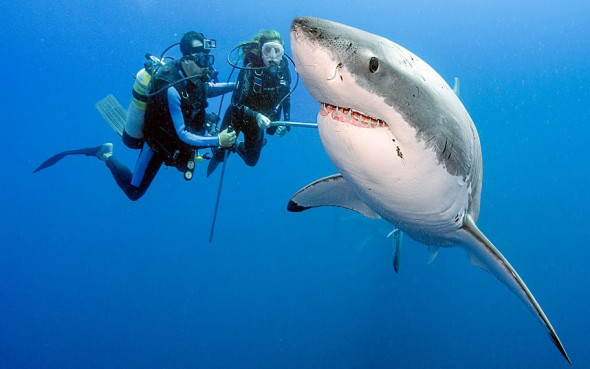
Sharks are one of a kind of Chondrichthyes that have swam the planets oceans for millions of years dating back to the prehistoric realms of the dinosaurs, living through the ice ages, colossal seismic activity that saw many millions of oceanic species wiped out. The shark though a silent stalker and predator remained unscathed.
They were not in any real danger to of traditional Chinese medicine demand or pollution and swam within the oceans with little if any predators, sadly this is hastily no longer factual and the entire species of sharks are being wiped out for a “soup” or medicine used frequently within the Asian medicine market just for tongue and texture.
The species of Shark are not mammalians they are classed as Chordates which is the only unique species of their type separating them from mammals, Chordate are deuterostome animals possessing a notochord, a hollow dorsal nerve cord, pharyngeal slits, an endostyle, and a post-anal tail for at least some period of their life cycles that then develop into the species of which the Deoxyribonucleic acid is programmed to make them into.
Being relatively blind they are agile swimmers yet superb deep sea divers that can smell through an array of senses a drop of blood in the ocean from half way around the world which scientifically is factual although they cannot exactly home in on this being some thousands of miles away there smell is unique from any other form of fish, human or other mammal predator.
The shark noses use ‘smell stereo’ to detect tiny delays no more than half a second long in the time that odours take’s to reach one nostril compared to the other one and that truly is amazing. All species including the deep sea sharks use a combination of directional cues based on scent and the flow of water - to keep them orientated and find what they are searching for.
So the theory that they are human eating man eaters which coincidentally is what the Asians believe hence why they like to consume as well parts the Panthera tigris as in their fake book of counterfeit medicine it states the shark “is a beast and man eater with much energy” that should they consume the shark it will make them a fiery hunter in bed. Its utter nonsense, scientifically untrue, and fairy land tails.
If the delay between the scent reaching one nostril and the other is between a tenth and half a second, the sharks turn their heads to the side where they first smelled the bleeding or anxiously suffering prey such as the squid one of the sharks favorite foods.
If a shark experiences no delay in scent detection or a delay that lasts too long a full second or more they are just as likely to make a left-hand turn as they are to make a right, which makes them rather interesting and a species we must all PROTECT”.
The popular notion that sharks and other animals follow scent trails based on differences in the concentration of odour molecules hitting one nostril versus the other are based on 2010 scientific analyses. It seems that theory doesn’t hold water when one considers the physics of the problem.
Most creatures come equipped with two odour sensors - nostrils or antennae, for example - and it has long been believed that they compare the concentration at each sensor and then turn towards the side receiving the strongest signal.
‘But when odours are dispersed by flowing air or water, this dispersal is incredibly chaotic.’
This recent research on sharks predatory hunting behaviour living has led to findings that has also lead to underwater robots that are better equipped to find the source of chemical leaks, like the oil spill that plagued the Gulf Coast in 2010, 2012 has already seen this research placed to use in many “deep-sea” submersibles now actually using this research to develop state of the technological maritime breakthroughs that have seen many documentaries recorded and sea bed chemical leaks from pipes that are not that easily traceable by other older technologies that can break down at the blink of an eye lid.
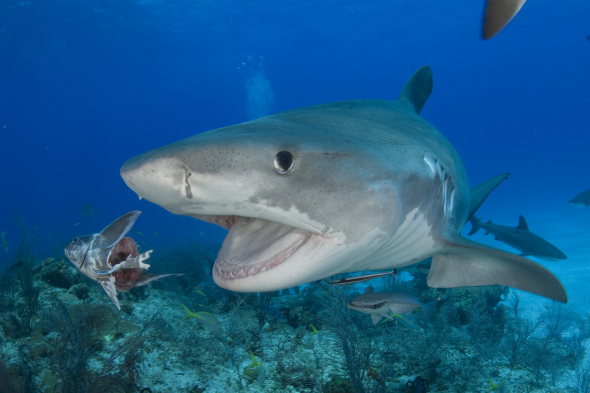
Previous robotic submersibles were programmed to track odours by comparing odour concentrations, and they failed to function as well or as quickly as live animals.
The oil spill in the Gulf of Mexico, and main oil slick was easily visible and the primary sources were easy to locate, smaller sources of Odour-guided robots are an asset for these types of situations with great thanks to the sharks.
The smell organs in the noses of some sharks are able to detect one droplet of blood in one million drops of sea water. They are often attracted to chemicals found in the guts of animals and loiter near sewage outlets so this great research has helped many in the maritime industrial.
Sharks have swam the oceans as far back as we can tell for about 400-500 million years of which there was an estimated 480 species that belong to the subclass of Elasmobranchii, which is in non-scientific jargon cartilaginous fish such as rays which makes them quite different from normal species of fish such are whales that are a sub class of Eutheria distinguished from noneutherians by various features of the feet, ankles, jaws and teeth.

One of the major differences between placental and nonplacental eutherians is that placentals lack epipubic bones although fish don’t have feet, some species that moved from land to waters thousands of years ago have then later evolved in to this “subclass” which the shark species are a subclass of their own from what we know of million year old fossil investigations through archaeology.
Most sharks such as the Carcharodon carcharias, Galeocerdo cuvier, to the Sphyrna lewini are classed as “apex hunters” which basically means they are at the top of the human food chain, they are feared by ourselves even though attacks are rare and just to give you an example of shark attacks verse the bathroom toilet.
Shark attacks for 2011 where 75 global shark attacks, a number closely matching the decade average and the number for 2012 was from what I located to be 62 although that is still to be confirmed surfers and others involved in board sports took the brunt of the attacks, accounting for 60 per cent of unprovoked shark attacks, swimmers 35 percent and divers about 5 per cent.
However the bathroom toilet is quite amusingly odd in 1945, the German submarine U-1206 was sunk after the toilet malfunctioned, and a crewman’s botched repair forced them to the surface killing all on board. King Wenceslaus III of Bohemia was murdered with a spear while sitting in the garderobe (toilet) on August 4, 1306. George II of Great Britain died on the toilet on October 25, 1760 from an aortic dissection. According to Horace Walpole’s memoirs, King George “rose as usual at six, and drank his chocolate for all his actions were invariably methodic. A quarter after seven he went into a little closet. His German valet de chambre in waiting heard a noise, and running in, found the King dead on the floor.” In falling he had cut his face.
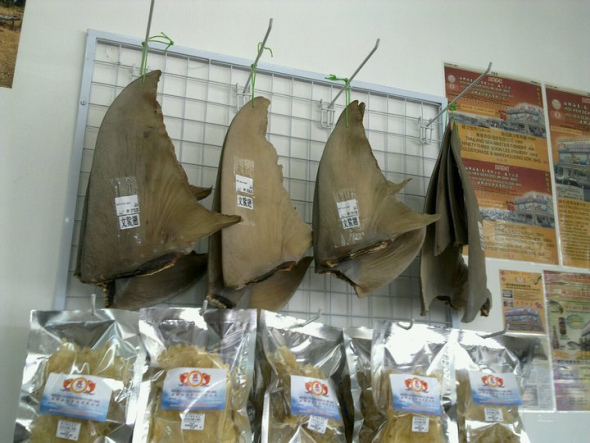
Bathing and showering appear to be particularly dangerous. Overall, about two-thirds of accidental injuries happen in the bathtub or shower — which makes sense, because each can become slippery. But many injuries involve the toilet: standing up, sitting down, or using it. (Yes, about 9% of the total injuries were from overexertion.)
Still believe that shark attacks are common and they are “aggressive out of control people eaters” ridiculously untrue please read on. Overall, mishaps near the bathtub, shower, toilet and sink caused an estimated 234,094 nonfatal injuries in the U.S. in 2008 among people at least 15 years old, the Centres for Disease Control and Prevention reported online in its weekly Morbidity and Mortality Weekly Report. And the injury rate rises with age.
Researchers used emergency room data on accidental, nonfatal injuries and some statistical number crunching to reach their conclusions. Their report is full of statistics (which makes it good bathroom reading, if you have 15 minutes and an Internet connection) on the slips, sprains, contusions, fractures and concussions that can happen in the bathroom, to even death.
- About 81% of the injuries were caused by falls (from the bathroom toilet)
- Women were more likely to be hurt than men
- Two-thirds of all injuries occurred in the tub or shower, though only 2.2% occurred while getting into the shower or tub
- Overall, only 1% of accidental nonfatal injuries occurred in the bathroom, but for those 65 and older, 2.5% occurred in the bathroom.
The report can be located here http://www.cdc.gov/mmwr/preview/mmwrhtml/mm6022a1.htm?s_cid=mm6022a1_w how prevailing and odd but very true, so the next time someone states to you that sharks are people eaters and aggressive please remember when you go to the bathroom that your actually “risking your life” Shark attacks though are very unheard of however the reason why they are classed as man eating killing machines is because the press adore to give them a rather bad name.
Such as “GREAT WHITE TORE MAN’S LEG OF” I suppose the headlines “MAN FELL FROM TOILET SEAT AND DIED” just don’t make GREAT reading which is why the press love to make such a mountain out of a molehill over something that could actually be a probing nip which is what a shark will do before “any such attack” takes place. http://mauinow.com/2011/06/07/study-details-hunting-behavior-of-tiger-sharks/
http://www.livescience.com/12783-shark-attacks-hit-10-year-high.html shark attacks on humans only hit a ten year high from recent accident and emergency reports gained from”2011” from all global hospitals. Extraction from the report states;
“Scientists investigated 115 alleged incidents of struggles between humans and sharks worldwide in 2010. They confirmed that 79 of these were unprovoked shark attacks on live humans”.
“Unprovoked attacks are ones that occurred with the predators in their natural habitats without human instigation. The other 36 incidents included 22 provoked attacks — such as assaults after divers grabbed sharks — including three cases of sharks biting boats, four incidents dismissed as non-shark attacks, five scavenging incidents of human corpses and two cases where there was not enough information to determine if an unprovoked shark attack had occurred”. Please read the report as it gives scientific reasoning as to why they have attacked more within the 365 day period. http://dsc.discovery.com/sharks/why-do-sharks-attack.html
What does all this have to do with sharks and the species under threat though? Good question as most of this does as of lack of awareness, the fright factor, and then of course traditional Chinese medicine the NUMBER ONE REASON.
There are MORE attacks on sharks than there are on any other species of fish, and now we need to start taking note of this as we are losing these amazing species rapidly due to counterfeit Asian pharmaceuticals and the disgustingly tasting shark fin soup.
I have always been a firm lover of wild and “predatory dangerous” animals such as mammals from the big lion to Tiger’s, reptilians from Python to Crocodile, and marine aquatic species mainly the shark. In 2010 I traveled to Shenzhena bustling rather smog filled sky scraped city that had many restaurants and street quick food fixes mainly selling animal parts to eat of which shark fin was on the menu.

Thousands of Sharks lay dead in a Singapore fishmongers. Within central China it is said by many, and even activists that the sharks are only craved for, for their fins. This is untrue and this picture was taken three days ago in Singapore’s market. The market sells the shark meat and the fins for major profit making Singapore one of the richest Asian islands in the world.
Being a firm lover of sharks and great studier of the species I wanted to see what all the fuss was about and why sharks where being wrenched out of the water like candy from a baby then de-finned and thrown back to the seabed from which they died a slow agonising death from asphyxiation. Being a vegan for thirty years I really couldn’t care at that point as the main objectives was to try this dish to see if this was indeed a great reason why it is used in Asian medicine, to try and ascertain why one of my favorite species of animals was being slaughtered,
The soup smelt repulsively strong and acidic, and when tasting it without almost vomiting, one can only explain that even with a sprinkle of chive that entire first spoon and that being the last, tasted revolting, and more like hot water with the odd lump of shredded fish cuisine within. Oh yes I forgot the tender informed me that it would make me fit and strong even though I already was in 2010 being a healthy vegan for over 30 years.
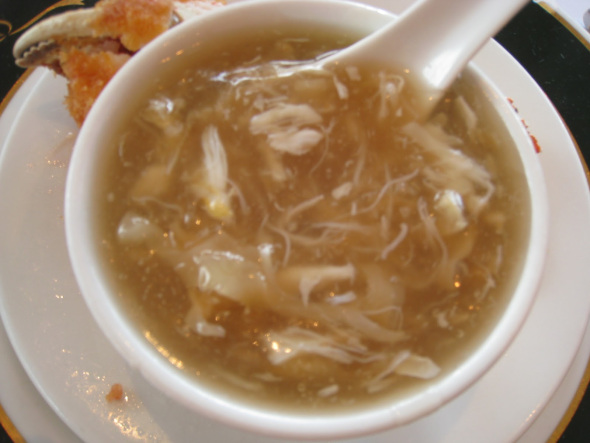
https://www.facebook.com/SingaporeFoodRecipes
DISGUSTING AND BLOODY CRUEL - THIS IS ONE RESTAURANT THAT NEEDS BOYCOTTING
The soup did nothing, and there was no magical dragon like hallucinogenic that gave me the power of a thousand men. “Shark fin soup does not under any circumstances improve erectile dysfunction (not that I tried), enhance muscle power, to even warding of any diseases/illness that I actually picked up from visiting the shite hole city of smog and environmental pollution, it does nothing and has no proven health qualities at all. The one spoon fall of fowl tasting crap was enough to show to me that one of the most majestic creatures on earth was being slain for “monetary gain” and not any magical belief. Utterly unbelievable.
Chinese Shark Fin soup is a “luxury” food served (mainly) at banquets, weddings, parties and cultural masses, however it’s killing the species of and rapidly. The Chinese claim “The shark fins provide texture while the taste comes from the other soup ingredients. The soup originated centuries ago during the Ming Dynasty.
However demand for the soup has increased as income levels of Chinese communities worldwide have risen. International concerns over the sustainability and welfare of sharks have impacted consumption and availability of the soup. So because the Asian consumers require “texture” to their soup then sharks have to be slaughtered in their thousands. There is such thing as we croutons or (toasted bread) that add more texture to this pile of watered down crap which contains one of my favorite animals.
It is estimated that 100 to 200 million sharks annually are killed for their fins alone that’s seen many species now pushed to the brink of extinction and just to give an insight of how bad a problem this is please view the link http://www.foxnews.com/world/2013/01/04/hong-kong-traders-dry-thousands-shark-fins-on-roofs-to-avoid-scrutiny/
Sharks that are caught and their fins cut off are not always dead when their bodies are thrown back into the sea. Without its fins the shark simply sinks to the bottom of the ocean where it dies. Such a horrible death for such a magnificent creature and diet, the whole entire practice is unethical, environmentally damaging and will cause havoc in the biodiversity predatory hunting circle if we lose our species of sharks.
Shark fins, once they are harvested, are then dried to be sold in markets to individuals and restaurants to be made into shark fin soup and sold to the public (especially tourists) for as much as $350 per bowl! The shark fins don’t even add any flavor to the soup. Chicken or pork are used to flavor, the fins are for texture only.
The shark fin soup industry uses a wide variety of relatively large sharks. The majority of these sharks are now under threat. They are slow to mature and breed sharks give birth to a few live young or lay a small number of large eggs depending on species, rather than produce thousands of eggs at a time in the manner of many bony fish. Large sharks also do not mature until they are several years old. These characteristics mean that shark populations cannot support high levels of exploitation = nearing extinction to species vaporisation for a bowl of lousy fowl tasting soup.
Mackerel Sharks
The order Lamniformes includes some of the best-known and biggest sharks. Among them are the great white shark, the basking shark and the thresher sharks. All these species are targeted for their fins, and all are either endangered or vulnerable. The great white shark, for example, might be the most feared species of shark, especially after starring in the ’70s thriller “Jaws.” However, they are more threatened by humans than humans are by them.
Ground Sharks
Carcharhiniformes is another order boasting well-known sharks, such as the bizarre looking hammerheads, whose fins command high prices. The order also includes the family of requiem sharks. These are sharks are your typical sharks, with streamlined bodies and sharp teeth. Tiger sharks, bull sharks and the spinner sharks, which jump out of the water, are all requiem sharks, and they are all taken for their fins.
Dogfish
The order Squaliformes includes all the sharks known as dogfish, the bramble sharks and the rough sharks. They are generally small, benthic, seabed-dwelling sharks that lay eggs and reproduce relatively quickly. Their fins are not of much value, although these animals are often targeted for their meat. The tails of some species of dogfish are used for cheap versions of shark fin soup.
Of the five remaining orders of sharks, carpet sharks, bullhead sharks, angel sharks, frilled sharks and saw sharks, few species are used for shark fin soup. They are mostly small sharks, with small or undesirable fins, and they are not valuable in the shark fin market. Some species, notably the critically endangered angel sharks and the whale shark — a species of carpet shark and the largest fish in the world — are targeted for their meat or oil, but not the fins.
If we don’t take urgent notice now and demand that CITES Convention on International Trade in Endangered Species of Wild Fauna and Flora take more action and demand that law enforcement cease this repulsive and degrading trade then we will see an ocean without any sharks that will unfortunately create a massive aquatic biodiversity nightmare in the aquatic hunting food chain.
Sharks eat many prey, these prey need to be naturally controlled to preserve OTHER species of smaller aquatic marine fish, and should the shark numbers carry on dwindling at massive proportions then we are heading for a global catastrophe.
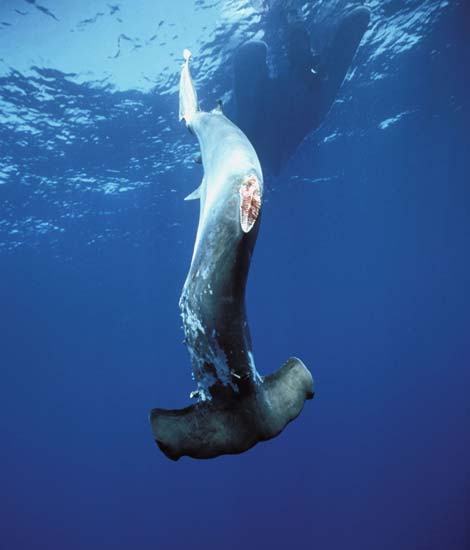
THE SLAUGHTER HAS TO END NOW - PLEASE TAKE IMMEDIATE ACTION AND NEVER GIVE UP HOPE
http://www.hongkong-companies.com/wo-loong-ho-sharksfin-company-limited-b1v6/
https://www.facebook.com/pages/Shark-Fin-Chinese-Bistro-Pensacola-FL/269850188099?fref=ts
PLEASE DEMAND CITES TAKES MORE ACTION NOW BEFORE MARCH OF THE FOLLOWING SPECIES LISTED ABOVE AND BELOW.
Mackerel Shark
Ground Shark
Dog fish
Bullhead shark
Angel Sharks
Frilled Sharks
Lemon Sharks
Saw Sharks
Hammer Head Shark
Reef Shark
PLEASE CONTACT / DEMONSTRATE / PETITION / - 33 DAYS LEFT BEFORE COP 16TH MEETING
CONVENTION ON INTERNATIONAL TRADE IN ENDANGERED SPECIES OF WILD FAUNA AND FLORA;
CITES Secretariat
International Environment House
11 Chemin des Anémones
CH-1219 Châtelaine, Geneva
Switzerland
Tel: +41-(0)22-917-81-39/40
Fax: +41-(0)22-797-34-17
Email: info@cites.org (email them hard to get a response)
CONTACT IUCN (International Union for Conservation Nature)
IUCN Conservation Centre
Rue Mauverney 28
1196, Gland, Switzerland
Opening hours: 8:00 to 17:30 Monday to Friday (except Swiss public holidays).
Phone: +41 (22) 999-0000
Fax: +41 (22) 999-0002
Dr J C Dimetri V.M.D, B.E.S, Ma, PhD , MEnvSc
Please support our fundraiser for Benue http://fnd.us/c/3PFe2
Kami ingin mengingatkan orang-orang yang mengirimkan pesan yang tidak diinginkan bahwa situs Anda akan menutup jika Anda tidak berhenti.
We wish to remind all that visit that should you spam “your sites and the server sending to individual registering shall be reported with IP shut down regardless of whom you are” we take spamming seriously and we advise you to cease now.
CHINA STATED IN 2010 AND 2011 THAT THEY WHERE GOING TO BAN CIRCUSES AND THE DOG AND CAT MEAT TRADE (LIES)
ANOTHER ASIAN GOVERNMENTAL LIE - MEDIA FALL FOR THEIR LIES - CHINA CANNOT EVEN REMOVE THE RHINOCEROS HORN OR IVORY THIS VIDEO BELOW IS JUST A PRIME EXAMPLE TO SHUT ACTIVISTS UP - THEY WILL CARRY ON AND STILL IMPORT..
11 months ago CNN stated that China was going to ban SHARK FINS - What China meant was (they where going to hide them from activists which is a common lie from Asia) video taken over three ago.. How coincidental.

